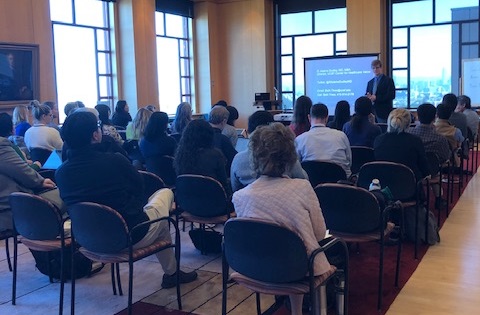Reduce costs | Increase value | Enable innovation
Teaching to Choose Wisely: The UCSF Center for Healthcare Value Funds a Project Related to Medical Device Regulation
Dear CHV Community and Partners,
The UCSF Center for Healthcare Value (CHV) is excited to announce support of a new project as part of its Teaching to Choose Wisely Initiative. The project was made possible through a partnership with CHV and the Haile T. Debas Academy of Medical Educators’ Innovations Funding Program.
The project is entitled “Development of a Digital Educational Toolkit on Healthcare Sustainability”, and is led by Dr. Seema Gandhi, Professor of Anesthesia at UCSF. The team will create a digital curriculum featuring an online, self-paced course to educate UCSF graduate medical education learners about sustainable healthcare practices. The project will include identifying knowledge gaps, providing the tools to implement evidence-based sustainable mitigation strategies in targeted healthcare specialties, and facilitating decarbonization and waste reduction efforts at UCSF Health.
Other UCSF School of Medicine project team members are Garrett Roll, MD from the Department of Surgery; Kaiyi Wang, MS from the Office of Sustainability; Hemra Cil, MD, Jennifer Sasaki Russell, PhD, and Christy Boscardin, PhD, all from the Department of Anesthesia and Perioperative Care.
“The current undergraduate medical education curriculum at UCSF includes optional content on environmental sustainability and climate change. Notably, this content is neither covered in the graduate medical education curriculum nor as part of continuing medical education courses available to faculty,“ said Dr. Gandhi. The base content of the course will feature core information on the intersection of healthcare and climate change that is relevant to all healthcare professionals. “The creation of this curriculum on sustainable healthcare will provide a new method for engaging clinicians at UCSF in the fight against climate change,” she said.
The overarching goal of the project is to teach real-world sustainable modifications that UCSF learners can implement in their daily clinical practice while simultaneously stimulating and engaging learners to become proactive sustainability champions in their field.
“We believe the development and utilization of this educational module will raise awareness of the environmental impacts of the healthcare industry, increase the adoption of sustainable practices at UCSF Health, and aid in the reduction of the facility’s environmental impact,” said Dr. Gandhi.
The CHV is excited to support this project in partnership with the Academy. The focus on sustainability is well-seated within our central mission of improving healthcare value, and we look forward to strengthening the curriculum in this area at UCSF and beyond.
The UCSF Center for Healthcare Value Announces 2023 “Blue Ribbon Awards for High-Value Care”
The UCSF Center for Healthcare Value (CHV) has designated 11 projects submitted to the 7th Annual UCSF Health Improvement Symposium as receiving “Blue Ribbon Awards for High-Value Care”. The award targets projects geared toward reducing costs, improving value and reducing waste.
This year’s Blue Ribbon Awards were given to the following projects and teams:
- A Quality Improvement Initiative to “Supercharge” Early Morning Discharge Orders Placed Before 8am - Michael Love, MD and team
- Harm Reduction through Appropriate Vascular Access Device Selection by Leveraging the Vascular Access Specialty Team - Michele Nomura, MSN, RN, CNRN, VA-BC and team
- Home Alkalinization to Shorten LOS for Patients Receiving High-Dose Methotrexate - Vivian Huang, MS, RN, CNS and Amanda Ernzer, MS, RN
- Identifying Proactive Approach to Fall Prevention by Promoting a Safe and Effective Hospital Environment that Prioritizes Patient Safety and Well-being - Alma Cabading, 9L Unit Director and team
- Impact of Novel Integration of Physical Therapy in the OPTIMAL Long Covid/Post ICU Clinic - Yumi Kawakami, PT, DPT and team
- Impact of Pharmacist Integration into UCSF OPTIMAL/Pulmonology Clinic - Rima Bouajram, and team
- Improving the Timeliness of NICU Discharge - Priscilla Joe, MD and team
- Jade: The ED's Hidden Gem - Murphy Ellis BSN, RN, CEN and team
- Maximizing Performance Capture - Erin Perez Gamblin and team
- Patient Capacity Management Center: Building the Ecosystem - Toni Braden, DNP, RN and team
- Reducing Unnecessary Radiation Exposure from Chest X-rays in Lung Transplant patients - David M Gordon, DNP & Jasleen Kukreja, MD
The CHV extends hearty congratulations to these project leaders and their teams for their devotion to promoting high-value care at UCSF and beyond.
Read about past Blue Ribbon Award winners here.
Improving Value Together
Visit our CHV Resources page to learn more about starting, implementing, or sustaining value work at UCSF.

High Value Care Seminar Video Series Sponsored by the UCSF Center for Healthcare Value
View Video Series here

